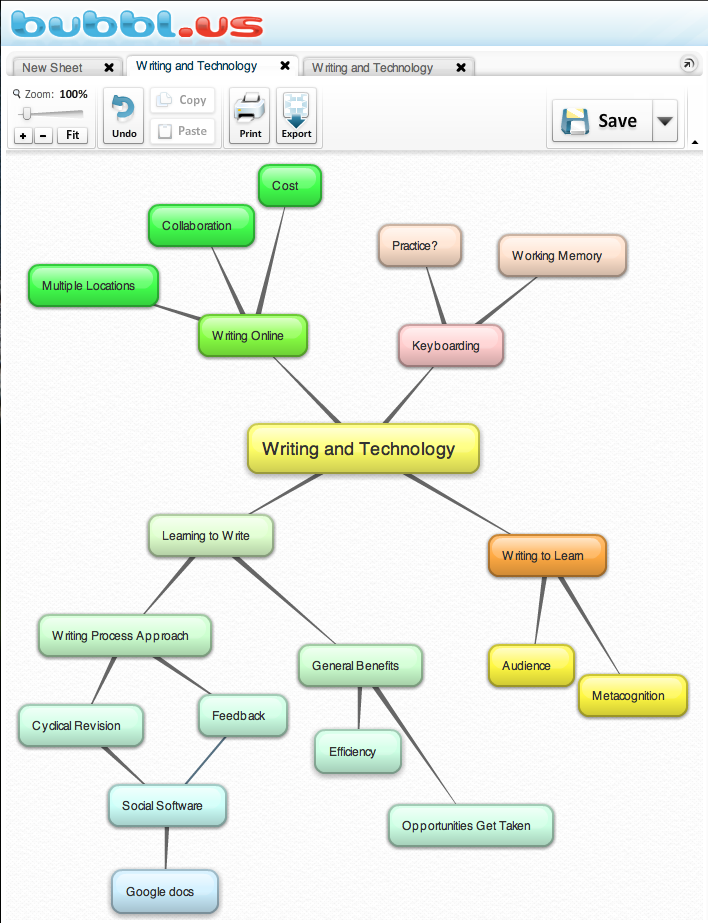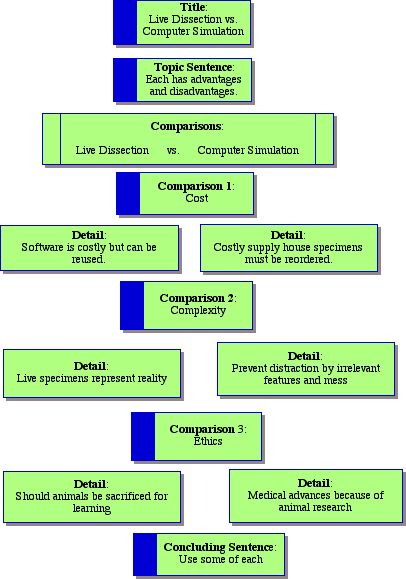
Using Concept Mapping Applications to Brainstorm
Our Primer description of some of tools that are often used in collaboration with core word processing features to improve the writing process included mention of concept mapping. Here we provide some examples of concept mapping software and of ways in which the software can be applied.
Brainstorming, as part of a problem-solving task, might be described as the nonjudgmental process of generating and organizing ideas. A tool suited to this process should make it easy to (1) record ideas as they are generated, (2) organize ideas that have been generated into some type of meaningful structure, (3) record additional comments related to individual ideas without creating a confusing display, and (4) allow easy modification of both content and structure.
Concept mapping, sometimes called mind mapping, applications are designed to encourage the production and organization of ideas and are therefore perfect for brainstorming activities. Ideas (concepts) are identified as nodes and are typically linked to identify the relationships among the ideas (see figure 3.Bubbl.us). In some applications, the links can be labelled to identify the nature of the relationship (e.g., example of, causes) and in some applications nodes can be represented as images, web links, or extended segments of text. In all concept mapping applications, ideas and the structure of ideas can be treated independently. That is, the ideas can first be generated and then linked in whatever fashion suits the nature of the information (e.g., hierarchical, web, sequence). Once generated, both the idea elements and the structure of connections among the elements can be edited to explore new arrangements or to refine the final representation to emphasize only the most desirable elements.
Our first example is an online application called bubbl.us. This free, on-line tool can be accessed from any computer with an Internet connection and browser. The tool allows the user to generate node-and-link concept maps and to share these concept maps with others or if desired to collaborate with other designated bubbl.us users in creating maps. The alternatives of working privately and sharing a product, or working collaboratively represent options that can be quite important to educators depending on the situation and student group. The image that appears below was generated by exporting a sample map as a jpeg image. The original maps, called “sheets” within the bubbl.us environment, are stored “in the cloud” and the “embed code” for a sheet can be used to insert a map in a blog or web page.

Concept mapping and outlining tools can prove helpful to individual writers as they think through their goals and generate the structure of a future document. Because of the visual nature of concept maps, such tools can also be a very useful tool for group planning in a classroom. In this case, members of a group might sit around a large screen or projected display and work to plan a project. Interactive white boards may come with software suited to this purpose.
Haynes and McMurdo (2001) propose a different way to apply concept mapping software to the writing process. Their instructional approach is based on Inspiration (™) templates that help learners build five different types of paragraphs (such as compare and contrast, classification, reason). Inspiration has been a popular commercial product first available as software to be installed on individual computers and now also available as an online product (http://www.mywebspiration.com). In this writing task, students are provided a specific template as the basis for a writing assignment.
The templates for the different types of paragraph originate from a common structure:
- Title
- Topic Sentence
- Supporting Sentence 1
- Supporting Sentence 2
- Supporting Sentence 3
- Concluding Sentence
Variations on this structure address the specific requirements of different paragraph types. For example, the supporting sentences in a compare-and-contrast paragraph identify points of comparison (a similarity or difference).
The following Figure shows one such template.

A paragraph based on this template might end up looking like this:
Live Dissection versus Computer Simulations in Biology Labs
Biology teachers can base lab experiences on live dissection or computer simulations, and each approach has both advantages and disadvantages. Lab costs are one factor teachers must consider. Dissection specimens ordered from a scientific supply house are costly and are typically discarded after each student group has completed the dissection assignment. Purchasing several copies of a software program may cost several hundred dollars, but the simulated dissections can be completed many times by many students. A second issue involves the complexity of working on live specimens. Some feel that learners are best served by exposure to the reality of living organisms. In contrast, others feel learners are just distracted by the blood and mess. Finally, there is what some would call the issue of ethics. One position is that animals should not be sacrificed for educational purposes. The opposing position is that many medical advantages have come from work with animals. Perhaps biology teachers should engage students with a few live dissections and with simulations in order to take advantage of the advantages of each approach.
Templates may help young writers in a couple of ways. The structure of the template eases the process of generating ideas. The required elements give writers a place to start. The structure also helps the writer organize ideas free from the simultaneous demands of crafting prose. Writers get their ideas down first and then focus on writing a paragraph.
We encourage you to explore concept mapping. Some links you might explore follow:
